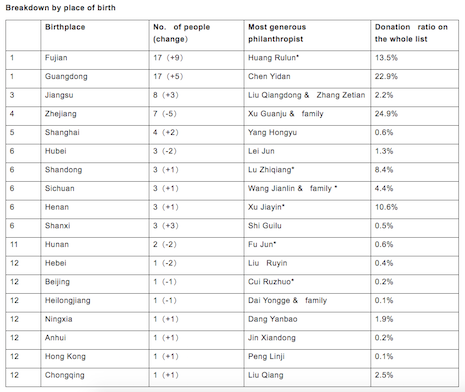 The largest section of luxury consumers are based in China, but most buy luxury goods outside the country. Image credit: Wikimedia
The largest section of luxury consumers are based in China, but most buy luxury goods outside the country. Image credit: Wikimedia
Overall donations to philanthropic efforts in China decreased this year by 45 percent, suggesting that wealthy Chinese customers may be feeling a bit more reticent with their cash.
This data comes from Hurun, which releases a Philanthropy List each year that catalogues the charitable donations of China’s most wealthy citizens. Keeping an eye on how freely affluents are giving can be a solid indicator of how much they are willing to spend on luxury goods as well.
“Generally speaking, entrepreneurs in China are still busy making their money," said Rupert Hoogewerf, chairman and chief researcher of the Hurun Report, Shanghai, China. "The Number 100 on the Hurun Rich List has shot up seven times, but the Number 100 of the Hurun Philanthropy List has stayed the same, at $2 million.”
Philanthropic efforts
China has seen significant growth in the amount of wealthy citizens it has.
This has been a figure of significant interest in the luxury industry, given the outsized amount of spending on luxury goods that comes from China.
In fact, Chiense customers are the largest single consumer bloc of luxury goods in the world. Dealing with that reality has been a major focus of the luxury industry and related research.
 China's top 10 Chinese philanthropists. Image credit: Hurun Research
However, understanding the whims of Chinese consumers is not always easy. A good barometer of how freely a certain class of people will spend is measuring their philanthropic contributions.
Hurun released this year’s Philanthropy List, which showed a massive drop in philanthropy by wealthy Chinese consumers, although much of this can be attributed to a single source.
Chinese philanthropist Pony Ma gave so much last year that his relatively smaller donations this year reduced the overall levels of Chinese philanthropy. But even adjusting for that, Chinese donations are down.“
But overall donations are still down, suggesting that Chinese consumers might be a bit less liberal with how they spend this year.
Charitable donations
The main recipient of Chinese philanthropy this year was education. Hurun attributes this to the fact that China did not have any major disasters or other urgent events that would require emergency aid, freeing up affluents to donate their money to more long-term investments.
For luxury brands, philanthropy can be an excellent indicator of overall economic health and flexibility of the luxury-consuming class.
Luxury brands must understand that entering into the Chinese market requires more than just learning the language, it requires knowledge of an unfamiliar consumer ecosystem that is much different than what marketers are accustomed to in the West (see story).
China's top 10 Chinese philanthropists. Image credit: Hurun Research
However, understanding the whims of Chinese consumers is not always easy. A good barometer of how freely a certain class of people will spend is measuring their philanthropic contributions.
Hurun released this year’s Philanthropy List, which showed a massive drop in philanthropy by wealthy Chinese consumers, although much of this can be attributed to a single source.
Chinese philanthropist Pony Ma gave so much last year that his relatively smaller donations this year reduced the overall levels of Chinese philanthropy. But even adjusting for that, Chinese donations are down.“
But overall donations are still down, suggesting that Chinese consumers might be a bit less liberal with how they spend this year.
Charitable donations
The main recipient of Chinese philanthropy this year was education. Hurun attributes this to the fact that China did not have any major disasters or other urgent events that would require emergency aid, freeing up affluents to donate their money to more long-term investments.
For luxury brands, philanthropy can be an excellent indicator of overall economic health and flexibility of the luxury-consuming class.
Luxury brands must understand that entering into the Chinese market requires more than just learning the language, it requires knowledge of an unfamiliar consumer ecosystem that is much different than what marketers are accustomed to in the West (see story).
 Top Chinese philanthropists by region. Image credit: Hurun Research
The Chinese desire for philanthropic donations can also be harnessed in a similar manner to a Western idea that recently popped up called Olivela.
Olivela is a new Web site where luxury shoppers can browse and purchase from their favorite brands with a discount. Each item listed on the ecommerce platform will impact a charity that has partnered with Olivela, which will be detailed on each product page (see story).
If luxury brands can integrate philanthropic donations into their purchases, they may be able to attract some of the more charitable-minded Chinese consumers.
“Chinese most generous philanthropists donate about 1 percent of the total personal wealth, while ordinary high-net worth donors should be 1 percent of the investable assets," Mr. Hoogewerf said.
Top Chinese philanthropists by region. Image credit: Hurun Research
The Chinese desire for philanthropic donations can also be harnessed in a similar manner to a Western idea that recently popped up called Olivela.
Olivela is a new Web site where luxury shoppers can browse and purchase from their favorite brands with a discount. Each item listed on the ecommerce platform will impact a charity that has partnered with Olivela, which will be detailed on each product page (see story).
If luxury brands can integrate philanthropic donations into their purchases, they may be able to attract some of the more charitable-minded Chinese consumers.
“Chinese most generous philanthropists donate about 1 percent of the total personal wealth, while ordinary high-net worth donors should be 1 percent of the investable assets," Mr. Hoogewerf said.
